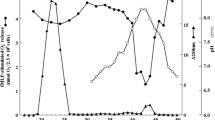Abstract
Human neutrophils exposed to indomethacin demonstrate an enhanced capacity for superoxide ion (O −2 ) generation when stimulated with opsonized zymosan. Enhancement is not seen with indomethacin-treated cells exposed to solube oxidative stimuli. To further investigate this phenomenon, O −2 generation, chemiluminescence, and phagocytosis were assessed in human neutrophils preincubated with indomethacin. Zymosan-stimulated O −2 release was increased from 150 to 300% of controls in neutrophils exposed to 400 μg/ml. indomethacin. Enhancement was not reversed by removal of indomethacin from the medium prior to addition of the stimulus and was dose-dependent at drug concentrations of 5 to 400 μ/ml. Neutrophils exposed to methacin alone also generated more O −2 than control cells, although this increment was not sufficient to account for the degree of enhancement seen when indomethacintreated cells were exposed to zymosan. Neutrophil cehmiluminescence induced by zymosan was also increased by exposure to indomethacin, and at a drug concentration of 400 μg/ml (1.1 mM), enhancement randed from 253 to 333% of controls. As was observed with O −2 generation, chemiluminescence of neutrophils was increased in the presence of indomethacin alone, although, to a degree far less than was seen when drug-treated cells were stimulated with zymosan. Phagocytosis of radiolabeledS. aureus by neutrophils incubated with indomethacin was increased 13±5% over controls (P<0.01,n=5), but was unaltered by incubation of cells with the buffer used to solubilize the drug. The modest degree of enhancement of phagocytosis suggests that increased particle uptake is not the sole mechanism of oxidative enhancement. The data are in keeping with the hypothesis that indomethacin has a direct effect on the neutrophil plasma membrane and/or the O −2 -forming oxidase.
Similar content being viewed by others
References
D. English, J.S. Roloff andJ.N. Lukens,Chemotactic factor enhancement of superoxide release from fluride and phorbol myristate acetate stimulated neutrophils, Blood58, 129–134 (1981).
J.C. Gay, J.N. Lukens andD.K. English,Differential inhbition of neutrophil superoxide generation by non-steroidal anti-inflammatory drugs, Inflammation.,8, 209–222 (1984).
D. English, J.S. Roloff andJ.N. Lukns,Regulation of human polymorphonuclear leukocyte superoxide release by cellular responses to chemotactic peptides, J. Immun.126, 165–171 (1981).
J.M. McCord andI. Fridovich,Superoxide dimutase: an enzymatic function erythrocuprein (hemocuprein) J. Biol. Chem.224, 6049–6055 (1981).
E. Margoliash andN. Frohwirt,Spectrum of horse heart cytochrome c, Biochem. J.71, 570–572 (1959).
T.D. Horan, D. English andT.A. McPherson,Association of neutrophil chemiluminescence with microbicidal activity, Clin. Immunol. Immunopath.22, 259–269 (1982).
J. Verhoef, P.K. Peterson andP.G. Quie,Kinetics of staphylococcal opsonization, attachment, ingestion and killing by human polymorphonuclear leukocytes: a quantitative assay using [3H]thymidine-labeled bacteria. J. Immunol. Methods14, 303–311 (1977).
B.R. Anderson andL. Harvath,Light generation with Fenton's reagent. Its relationship to granulocyte chemiluminescence, Biochim. biophys. Acta584, 164–173 (1979).
J.C. Fantone andP.A. Ward,Role of oxygen-derived free radicals and metabolites in leukocyte-dependent inflammatory reactions, Am. J. Path.107, 397–418 (1982).
R.M. Arenson,Substrate-induced chemiluminescence of xanthine oxidase and aldehyde oxidase, Arch. Biochem. Biophys.,136, 352–360 (1970).
J.L. Skosey, D. Chow, E. Damgaard andL.B. Sorensen,Effect of cytochalasin B on response of human polymorphonuclear leukocytes to zymosan, J. Cell. Biol.57, 237–240 (1973).
I.M. Goldstein, D. Roos, H.B. Kaplan andG. Weissman,Complement and immunoglobulins stimulate superoxide roduction by human leukocytes independently of phagocytosis, J. Clin. Invest.56, 1156–1163 (1975).
D. Roos, J.W.T. Homan-Muller andR.S. Weening,Effect of cytochalasin B on the oxidative metabolism of human peripheral blood granulocytes, Biochem. biophys. Res. Commun.68, 43–50 (1976).
P. Patriarca, R. Cramer, S. Monclavo, F. Rossi andD. Romeo,Enzymatic basis of metabolic stimulation in leukocytes during phagocytosis: the role of activated NADPH oxidase, Arch. Biochem.145, 255–262 (1971).
L.C. McPhall, C.C. Clayton andR. Snyderman,The NADPH oxidase of human polymorphonuclear leukocytes. Evidence for regulation by multiple signals, J. Biol. Chem.259, 5768–5775 (1984).
S.H. Ferreira andJ.R. Vane, Mode of action of anti-inflammatory agents which are prostaglandin synthetase inhibitors. (Eds.S.H. Ferreira andJ.R. Vane), InAnti-inflammatory Drugs, Handbbook Exp. Pharm, 9th edn., vol. 11, pp. 370–371. 1979.
L. Kaplan, J. Weiss andP. Elsbach,Low concentrations of indomethacin ihibit phospholipase A 2 of rabbit polymorphonuclear leukocytes, Proc. Natl. Acad. Sci. USA65, 2955–2958 (1978).
J.P. Abita,Indomethacin is a competitive inhibitor of the binding of the chemotactic peptide formyl-metleu-phe to human polymorphonuclear leukocytes, Agents and Actions11, 610–612 (1981).
B.L. Short, M.K. Miller andJ.R. Fletcher,Improved survival in the suckling rat model of group B streptococcal sepsis after treatment with non-steroidal anti-inflammatory drugs, Pediatrics70, 343–347 (1982).
J.R. Fletcher andP.W. Ramwell,Lidocaine or indomethacin improves survival in babbon endotoxin shock. J. Surg. Res.24, 154–160 (1978).
J.R. Fletcher andP.W. Ramwell,E. coli endotoxin shock in the dog: treatment with lidocaine or indomethacin, Br. J. Pharmac.64, 185–191 (1978).
P. Fowler,Phenylbutazone and indomethacin, Clin. Rheum. Dis.1, 267–283 (1975).
Author information
Authors and Affiliations
Rights and permissions
About this article
Cite this article
Gay, J.C., English, D. & Lukens, J.N. Stimulation of neutrophil oxidative metabolism by indomethacin. Agents and Actions 16, 336–341 (1985). https://doi.org/10.1007/BF01982869
Received:
Issue Date:
DOI: https://doi.org/10.1007/BF01982869




